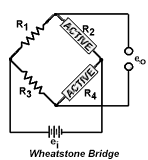






The accuracy of the strain measurement can be increased by having two or four arms of the bridge sensitive to strain. For example, if a beam is bending symmetrically about its axis, two strain gages can be used: one to measure the tensile strain and the second to measure the equal but opposite signed compressive strain.
For multiple-arm bridges, it can be shown that the output voltage will be given by:
(1)where:
 is the bridge output voltage,
is the bridge output voltage,
 is the bridge excitation voltage,
is the bridge excitation voltage,
 is the change in resistance of Resistor j (for j from 1 to 4), and
is the change in resistance of Resistor j (for j from 1 to 4), and

It can also be shown that, using the gauge factor relationship and Equation (1), the strain measured by the two active arm bridge, pictured above, is related to the output voltage by:
(2)where:
 is the strain to be measured,
is the strain to be measured,
 is the bridge output voltage,
is the bridge output voltage,
Notice that the bridge's output voltage is now twice as sensitive to fluctuations in resistance as it was for the single active arm case (thereby reducing uncertainty by a factor of 2.)